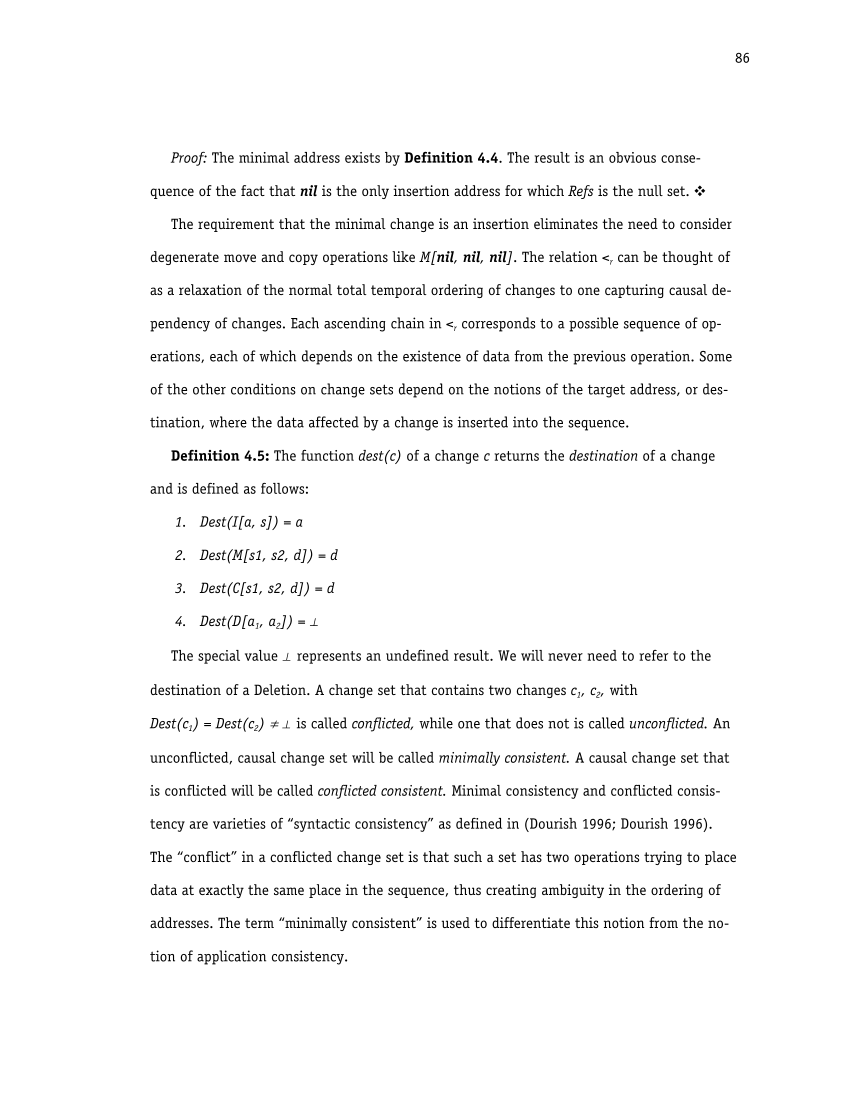86
Proof:The�minimal�address�exists�byDefinition�4.4.�The�result�is�an�obvious�conse-
quence�of�the�fact�thatnilis�the�only�insertion�address�for�whichRefsis�the�null�set. v
The�requirement�that�the�minimal�change�is�an�insertion�eliminates�the�need�to�consider
degenerate�move�and�copy�operations�like�M[nil, nil, nil].�The�relation<
r can�be�thought�of
as�a�relaxation�of�the�normal�total�temporal�ordering�of�changes�to�one�capturing�causal�de-
pendency�of�changes.�Each�ascending�chain�in�<
r corresponds�to�a�possible�sequence�of�op-
erations,�each�of�which�depends�on�the�existence�of�data�from�the�previous�operation.�Some
of�the�other�conditions�on�change�sets�depend�on�the�notions�of�the�target�address,�or�des-
tination,�where�the�data�affected�by�a�change�is�inserted�into�the�sequence.
Definition�4.5:The�functiondest(c)of�a�changecreturns�thedestinationof�a�change
andis�defined�as�follows:
1. Dest(I[a, s]) = a
2. Dest(M[s1, s2, d]) = d
3. Dest(C[s1, s2, d]) = d
4. Dest(D[a
1 , a
2 ]) = ^
The�special�value�^ represents�an�undefined�result.�We�will�never�need�to�refer�to�the
destination�of�a�Deletion.�A�change�set�that�contains�two�changes�c
1 ,�c
2 ,�with
Dest(c
1 ) = Dest(c
2 ) „ ^is�calledconflicted,while�one�that�does�not�is�calledunconflicted.An
unconflicted,�causal�change�set�will�be�called�minimally�consistent.A�causal�change�set�that
is�conflicted�will�be�called�conflicted�consistent.Minimal�consistency�and�conflicted�consis-
tency�are�varieties�of�“syntactic�consistency”�as�defined�in�(Dourish�1996;�Dourish�1996).
The�“conflict”�in�a�conflicted�change�set�is�that�such�a�set�has�two�operations�trying�to�place
data�at�exactly�the�same�place�in�the�sequence,�thus�creating�ambiguity�in�the�ordering�of
addresses.�The�term�“minimally�consistent”�is�used�to�differentiate�this�notion�from�the�no-
tion�of�application�consistency.
Proof:The�minimal�address�exists�byDefinition�4.4.�The�result�is�an�obvious�conse-
quence�of�the�fact�thatnilis�the�only�insertion�address�for�whichRefsis�the�null�set. v
The�requirement�that�the�minimal�change�is�an�insertion�eliminates�the�need�to�consider
degenerate�move�and�copy�operations�like�M[nil, nil, nil].�The�relation<
r can�be�thought�of
as�a�relaxation�of�the�normal�total�temporal�ordering�of�changes�to�one�capturing�causal�de-
pendency�of�changes.�Each�ascending�chain�in�<
r corresponds�to�a�possible�sequence�of�op-
erations,�each�of�which�depends�on�the�existence�of�data�from�the�previous�operation.�Some
of�the�other�conditions�on�change�sets�depend�on�the�notions�of�the�target�address,�or�des-
tination,�where�the�data�affected�by�a�change�is�inserted�into�the�sequence.
Definition�4.5:The�functiondest(c)of�a�changecreturns�thedestinationof�a�change
andis�defined�as�follows:
1. Dest(I[a, s]) = a
2. Dest(M[s1, s2, d]) = d
3. Dest(C[s1, s2, d]) = d
4. Dest(D[a
1 , a
2 ]) = ^
The�special�value�^ represents�an�undefined�result.�We�will�never�need�to�refer�to�the
destination�of�a�Deletion.�A�change�set�that�contains�two�changes�c
1 ,�c
2 ,�with
Dest(c
1 ) = Dest(c
2 ) „ ^is�calledconflicted,while�one�that�does�not�is�calledunconflicted.An
unconflicted,�causal�change�set�will�be�called�minimally�consistent.A�causal�change�set�that
is�conflicted�will�be�called�conflicted�consistent.Minimal�consistency�and�conflicted�consis-
tency�are�varieties�of�“syntactic�consistency”�as�defined�in�(Dourish�1996;�Dourish�1996).
The�“conflict”�in�a�conflicted�change�set�is�that�such�a�set�has�two�operations�trying�to�place
data�at�exactly�the�same�place�in�the�sequence,�thus�creating�ambiguity�in�the�ordering�of
addresses.�The�term�“minimally�consistent”�is�used�to�differentiate�this�notion�from�the�no-
tion�of�application�consistency.





























































































































































































